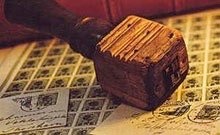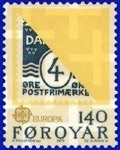My Faroe-Stamp’s collection
Postal History

My Faroe-Stamp’s collection
Postal History
Post-Offices

Eiði FO 652
Fuglafjørður FO 530
Husar - Mikladadur FO 797
Klaksvik FO 700
MykinesFO 388
Strendur FO 490
Vestmanna FO 350
In the Faeroes, Mail Service began in 1870, more precisely on March 1st, when the Danish Government, having the sovereignty on the islands, extended to them the regulation of its Mail System.
Actually, in the Faeroes, correspondence was already collected and delivered, and surely, at the beginning of the 19th century, there must have been a documented mail service.
For example, in 1813 was released an Act by the Royal Danish Chancellor that, dating back to a law from 1789, prevented anybody from getting possession of any material under the responsibility of the mail authorities.
On January 1st, 1856, the monopoly on trading, which had brought much poverty to the islands, was abolished, and the consequent increase in commerce began to promote the organization even in the mail systems.
Some ship-owners obtained concessions on some routes, and ships began to transport correspondence as well. Among them, there was the Koch & Henderson Society, which was the first to obtain the concessions for the Faeroes, and whose agent in Steymoy, H.G. Muller, used to organize the operations of discharge of the goods in 1863.
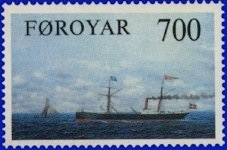
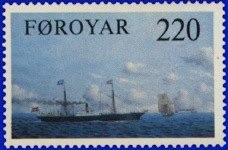
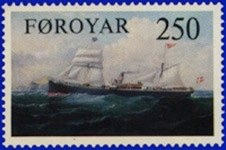
The ships used by Koch & Henderson in that period are documented:
Year Ship
1855 Fortuna
1857 Victor Emanuel
1858 Arcturus (ex Victor Emanuel)
1859 Odin
1864 Lady Havelock
1864 Phoenix
1868 Anglo Dane
With the introduction of the Royal Mail Service on March 1st, 1870, the concession was taken back and the service was given on a loan to the ship Diana, owned by the Government.
This lasted for some years, until in 1876, the concession was given back to Koch & Henderson, which by that time had turned into D.F.D.S. (Det Forenede Dampskibs-Selskab).
In the Faeroes, there was a local transportation system, called “Skjutsur”, which was also used for the mail.
The Skjutsur (“Skyds”, in Danish) was a system of transportation among the islands, both by land and sea documented from the 13th century. This organization was based on the single villages, which had people – usually the chiefs of the village - responsible for the transportation on foot of the letters between houses and cities. The mail service among the islands was made possible by rowing boats with a seat for religious of government functionaries.

This was considered the official system of mail transportation from 1798, and in 1865 the prices were also established.
The first real Faeroese Post Office was instituted on April, 1st, 1870, in Tornshavn, and its superintendent was H.G. Muller, the same agent for Koch & Henderson at the Faeroes, who, meanwhile, had also become “sýslumaður” (the local administrative authority, who functioned also as police officer, judge for minor trials, tax-collector, and coordinator for the distribution of whale-meat).
H.C. Muller maintained the position until 1897, when he died.
For the distribution of the mail between the Post Office of Torshavn and the islands, three new routes were defined and three new superintendents were nominated.
Superintendents Postal Routes
Johannes Christiansen Torshavn – Tvøroyri
(via Kirkjubøur, Skopun, Sandoy e Hvalba)
Hans A. Hansen Torshavn – Sandavagur
(via Kvivik o , tempo permettendo, Vestmanna)
Conrad Nicolaisen Torshavn – Klaksvik
(via Søldafjørður, Syðurgøta, Gøturgjogv, Norðragøta e Leirvik)
On March, 1st, 1884, the Post Office of Tvøroyri opened followed, on May 1st, 1888, by the one of Klaksvík. In Tvøroyri, as well as in Torshavn, the offices where managed by the "sýslumaður".
In 1903, seven other post offices were opened, and in the following twenty-five years many others opened in almost every other urban setting (fiveteen offices were opened only in 1918 !).
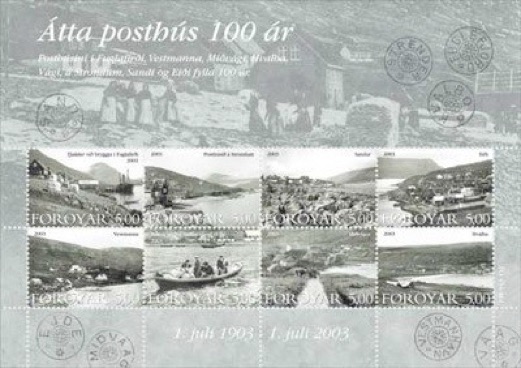
This tendency changed completely from 1960, when many post offices began to close. This tendency still continues to these days, where old offices are progressively substituted by post agents because of efficiency and economic problems.
Until April 1st, 1979, Faeroese Mail Service was maintained within the Danish mail system (Postal and Telegraph System). Back then, the Faeroese Mail was organized with a Main Post Office in Torshavn managed by a Mail Director and by functionaries that worked as agents at the offices of Klaksvík, Tvøroyri, Vágur, Vestmanna and Saltangará. All other offices were divided into two categories: “mail-collecting offices” and “mail-sorting offices”.
Between 1974 and1975, Danish Mail began to issue stamps of the Faeroes, mainly for philatelic interest. The first Faeroese emission was on January 1st, 1975, and from that moment, the interest for Faeroese stamps abroad had always increased, eventually becoming an important resource of the country’s exports.
An interesting period in the Faeroese philatelic history is the one immediately following the end of the I World War, when Faeroese post offices had to employ the so-called “temporary stamps”. On December 8thm 1918, the post office of Torshavn received dispositions from Copenhagen for the following price increases: from 5 to 7 øre for intern mail, from 4 to 7 øre for the ones to Denmark. The increase was announced for January 1st, 1919.
Because of the disastrous conditions of the sea, which was keeping the Islands isolated from the rest of the world, the new 7-øre stamps could not reach Torshavn in time, and the stock of stamps from 1, 2, 3 and 4 øre were not enough to satisfy the public demand. Therefore, the post office was authorized to cut the 4-øre stamp into two 2-øre stamp.
When also the 4-øre stamps were about to finish, the offices were authorized to over issue a certain number of stamps from 5 øre and to use them as 2-øre stamps. Therefore, it was made a hand-made over issue of an entire stock with the writing “2 øre”. The over issue was made with the leg of a chair (this stamp is known, in fact, as “the stamp of the leg”).
An analogous situation happened between 1940 and 1941, with the German occupation of Denmark.
The adjustment of the price was eventually solved with a rubber stamp with the price carved on it.
With the election of the Faeroese Parliament in November 1974, a proper Mail Service was established.
Consequently, two mail departments were established: the "Postage Stamp Department" and the "Post Office Giro".
Vagur FO 900
Home
English version
